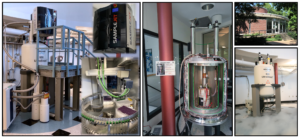Facility Spotlight: Biomolecular NMR

The Biomolecular NMR Facility is a state-of-the-art center located in the round building that is part of the Stevenson Center Complex on the main Vanderbilt campus. The staff are happy to help research groups start an NMR project, discuss the project specifications or do a pilot/feasibility study for a grant or a new research direction.
To schedule training or to find more information, visit the CSB NMR website or email Markus Voehler.
Who are the facility staff? The facility is led by Dr. Markus Voehler, research associate professor. The scientific director is Dr. Mike Stone, professor of chemistry.
What instrumentation and services are currently provided at this facility? The NMR facility houses five high-field NMR spectrometers, ranging from 500 to 900 MHz. One of the two 600’s, the 800 and 900 MHz spectrometers are equipped with cryo-probes that enhance the sensitivity of the NMR measurements and shorten experiment times. The higher field spectrometers in combination with the cryo-probes provide the highest sensitivity and resolution, which is necessary to better distinguish individual signals in larger molecules.
The other 600 and the 500 are equipped with broad band probes, allowing the detection of a wide range of nuclei. This allows for experiments recording atypical nuclei such as phosphorus and fluorine.
What are the kinds of scientific challenges which can be addressed using the instrumentation at this facility? While the determination of biomolecular structures by NMR often comes to mind first, we can do much more than that. Solution NMR is uniquely suited for studies in the physiological environment of biological systems. It is a great technique to study binding interactions between biomolecules or with small molecules, biomolecular dynamics, protein folding, solvation or mutation effects. We also do fragment-based drug discovery or metabolomic studies in biofluids on a regular basis.
What are some of the most interesting/challenging projects you’ve worked on here? The University has always been very supportive of our NMR center which allows us to do some cool experiments. For example, we have established protocols to get high quality data for both large proteins and membrane proteins in lipid environments, both of which are considered significant challenges in NMR.
Several research groups run entire chemical libraries on one of the 600 MHz instruments for their fragment-based screens to find lead compounds for drugs with specific interactions to their protein targets. We also utilize In Vitro Diagnostic Research (IVDr) screens, where entire metabolic or lipid profiles can be created and quantified. This is a new and very powerful diagnostic tool for biofluids.
What was your path to becoming a facility director, and your favorite part of this job? I have an extensive background in Small Molecule and Biomolecular NMR. I’ve been working at Vanderbilt for about 30 years after working as an NMR Spectroscopist for five years at the University of Zürich, Switzerland. I love to explore new NMR experiments and new tools, and I also know the spectrometer hardware and software well.
Leave a Response
You must be logged in to post a comment